MORE POWER, SCOTTY!
By the release of the new 1966 Triumph Bonneville T120 650, Meriden had had a few years to sort out the teething problems of the new frame and unit-construction engine, introduced in 1963. Most of the changes up to this point had been incremental, but now the real work was starting: how to get more power, more reliability, and less vibration out of the venerable 650 vertical twin. Things were really starting to heat up now, with the trickle of small displacement bikes from Japan starting to turn into a flood of larger, more powerful machines. For Triumph motorcycles, and the Triumph Bonneville in particular to maintain its position as one of the fastest production bikes in the world, serious work would need to be done, and fast!
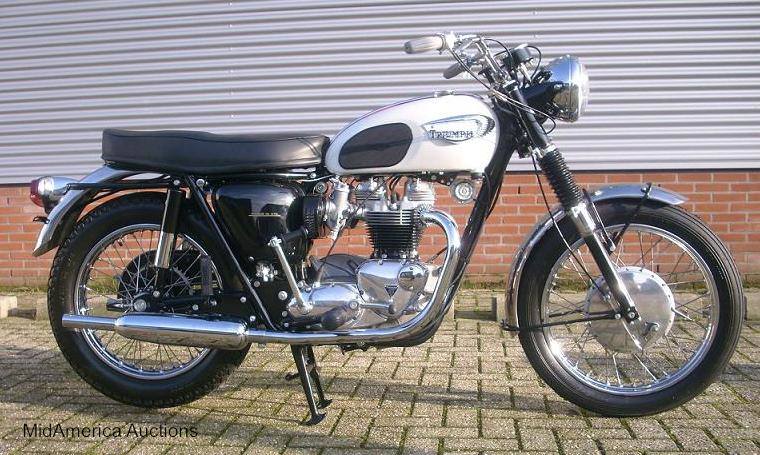
MODEL DESIGNATIONS
Model designations for the 1966 Triumph Bonneville line were as before: T120R was the Road version, T120C was the Off-Road/Street Scrambler (like an enduro), and the TT Special was the Competition version, basically a stripped down T120C with model-specific pipes (TT pipes) and special race tuning. The TT Special had never had it’s own separate designation, it was a T120C with an option package called the “TT Special”. This changed mid-year in 1966, when they became known as T120TTs, as they would until the model disappeared at the end of 1967. The paint scheme for 1966 differed for the first time from UK/Export and US models. UK and general export bikes were Grenadier Red with Alaskan White accents. US models were Alaskan White with Grenadier Red stripes (3 stripes running down the centerline of the tank, two thin stripes flanking one broad stripe, in the fashion of “racing stripes” on cars of the period).
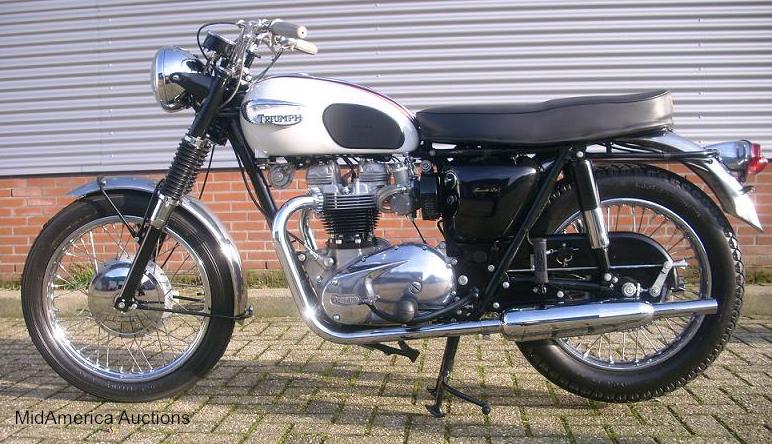
ABOVE: 1966 Triumph Bonneville T120R Roadster, with down pipes.
ENGINE
Inside the engine, things were heating up. Power output and vibration were at odds and it was only getting worse as more and more horsepower was demanded of the Triumph 650. An all new crankshaft shed 2-1/2 lbs of material from the edges of the flywheel, while retaining the 85% balance factor. A new 1-1/8″ shouldered roller main bearing (E2879) replaced the old ballrace on the drive side (left). Oil holes were drilled from the timing chest to the exhaust cam lobes to fight wear. The formerly-optional high-performance cams (E4819 inlet & E4855 exhaust) were now standard. Pushrod tubes and O-rings were revised to curb oil leakage (the pushrod tubes have always been a source of oil leaks in Triumphs, perhaps the worst source). New double valve springs, called “Red Spot” were introduced & the compression ratio was brought to 9:1 on non TT’s.
BIGGER CARBS
Starting with Engine #DU29738 all Triumph Bonnevilles got larger 1-3/16″ Amal Monobloc carburetors were fitted & the safety wires formerly on the float bowl cover disappeared. Then, starting with Engine #DU34086, the carbs got a #4 slide cutaway with a needle position of 2. Some US East Coast models got pancake air filters for the first time.
AMERICAN STANDARD
1966 also marked the beginning of the process of replacing all the old British Standard (Whitworth) nuts & bolts with Unified (American) threads. Over the next several model years there would be an odd mix of British & American threads. To own a Classic British Motorcycle used to mean you had to own a set of Whitworth tools. Now, you needed both.
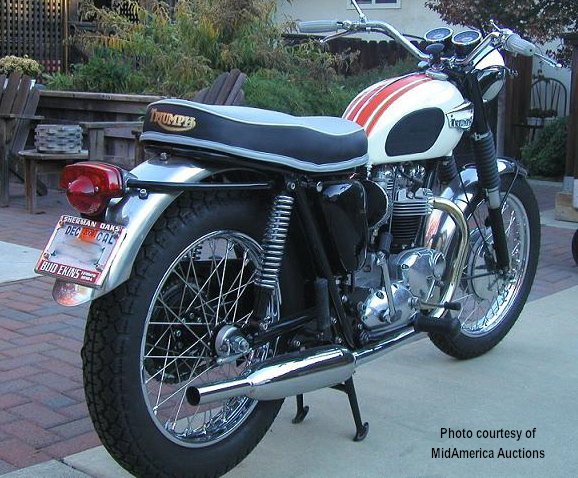
ABOVE: 1966 Triumph Bonneville T120R from the right-rear timing-side.
RUNNING GEAR
A longer kick starter lever was installed to help cope with the increased compression. The speedometer cable drive was moved off the layshaft (in the gearbox) to the rear wheel. Minor changes were made to the clutch & primary chain tensioner.
12 VOLTS
Perhaps the biggest news for the 1966 Triumph Bonneville was the adoption of 12 volt electrics. A new 12 volt alternator, Lucas MA12 coils, a Zener Diode (to control overcharging), a new rectifier, and two Lucas MKZ9E 6-volt batteries hooked up in series to make 12 volts. A new right-angle tachometer drive cleaned up the routing of the tach cable from the drive side of the exhaust cam to the gauges.
FRAME
The frame also received attention. Starting with Engine #DU25277, steering angle was brought from 65% to 62% to improve high-speed handling. The swing arm was widened by 1/4″ to make room for larger tires. Accommodation was made for a new battery box that came with the 12-volt electrics. The lower fork yoke (triple clamp) was changed to allow more steering lock, starting with Engine #DU27672. A new front brake (still an 8″ SLS as before) increased brake swept area by nearly 50% by increasing its width. The 46-tooth rear sprocket now became a bolt-on affair, rather than cast into the brake drum as before.
COLORS & TRIM
While most seats were the familiar 2-tone gray & black, some US models got all black seats. Rubber handgrips started out a pale gray (although they were referred to as ‘white’), but reverted to the more-practical black later in the year. US T120Rs also got polished stainless steel fenders to replace the painted ones. The gas tanks (both UK & US) were completely redesigned. The UK version still held 4 Imp. gals, but now had a slimmer profile and still fitted the chrome parcel rack on top. The US models dropped from an already short 3 gals to 2-1/2 gals and lost the luggage rack. The sexy new ‘teardrop’ shape became the symbol of Triumph motorcycles and Triumph Bonnevilles in particular to the public at large. The tank emblem was also changed from the old-style “harmonica” grille, to the cleaner & more-modern “eyebrow” badge, which would remain in one form or another for years to come.
1966 Triumph Bonneville TT SPECIAL
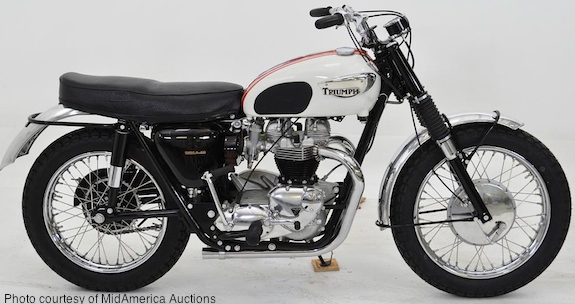
ABOVE & BELOW: 1966 Triumph Bonneville T120TT. This was the first year the “TT Special” had its own model designation. Until now, they were designated T120C’s just like the Street Scramblers.
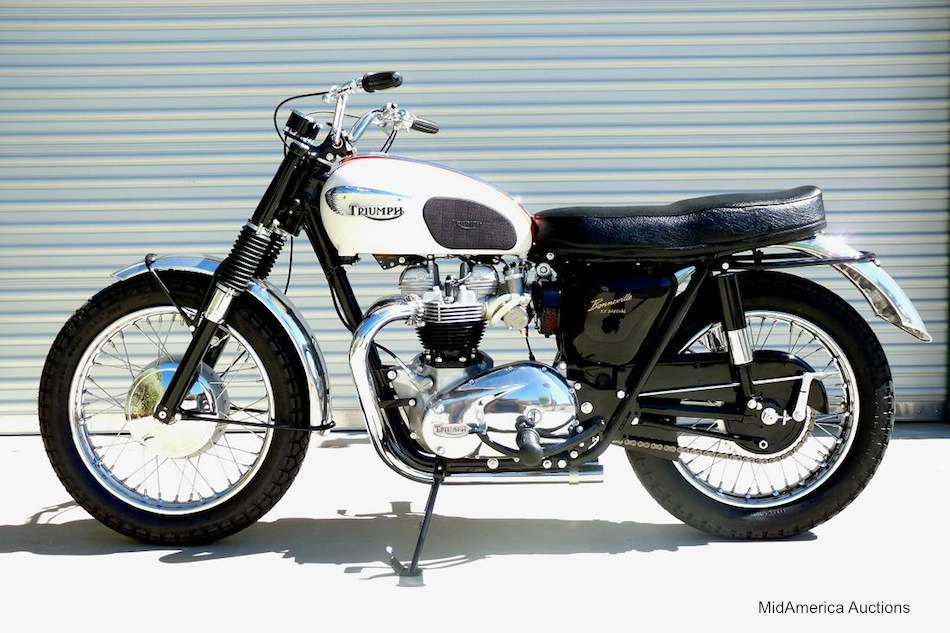
BELOW: The US version of the 1966 Triumph Bonneville got a new ‘slimline’ tank without carrying rack. It held just 2-1/2 gallons. Note how slim that ‘slimline’ tank really is on this 1966 Triumph Bonneville TT Special.
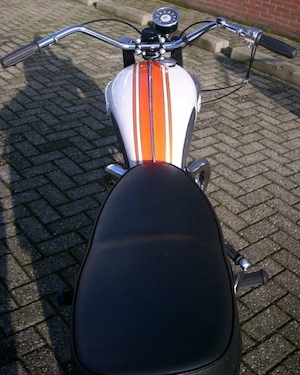
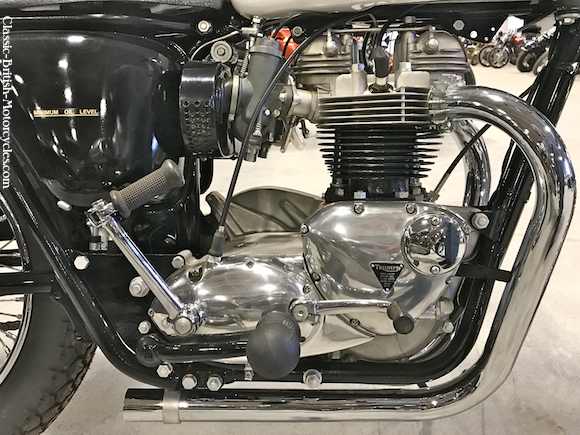
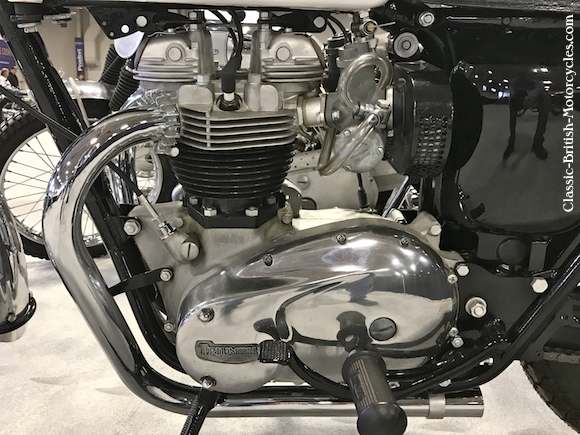
1966 Triumph Bonneville SPECIFICATIONS
|
Bonneville T120R Bonneville T120C Bonneville TT Special Engine type Displacement Bore & Stroke Compression Carburetors Ignition Engine output Primary drive Primary drive sprockets Clutch Gearbox Ratios, overall: 1st, bottom 2nd 3rd 4th, top Final drive Final drive sprockets Frame type Suspension, front Suspension, rear Brake, front Brake, rear Tire, front Tire, rear Fuel Capacity Wheelbase Seat height Ground clearance Weight, unladen |
Roadster, low pipes Street Scrambler, high pipes Competition, TT pipes Air-cooled OHV vertical twin 649cc / 40.0 ci 71mm X 82mm / 2.79″ X 3.23″ 8.5:1 (T120) / 11.0:1 (TT Special) 2- Amal Monobloc 1-1/16″ / 1-3/16″ (TT) Battery & coil (T120) / Energy Transfer (TT) 47 bhp @ 6500 (T120) / 52 bhp (TT) 3/8″ triplex chain X 84 links 29T X 58T Multi-plate, wet 4-speed constant-mesh, right-foot shift 11.8:1 8.17 6.76 5.84 5/8″ X .400″ X 3/8″ chain X 106 links 19T X 47T Brazed lug, full-cradle, single downtube Telescopic fork, hydraulic damping Swing arm, 2 Girling dampers 8″ SLS drum, full width 7″ SLS drum 3.25″ X 19″ Dunlop 4.00″ X 18″ Dunlop 2.5 Imp gal (US) / 4 Imp gal (UK & export) 54.5″ / 140.3cm 32.5″ / 77.5cm 5.0″ / 12.7cm 363 lbs / 165 kg |


